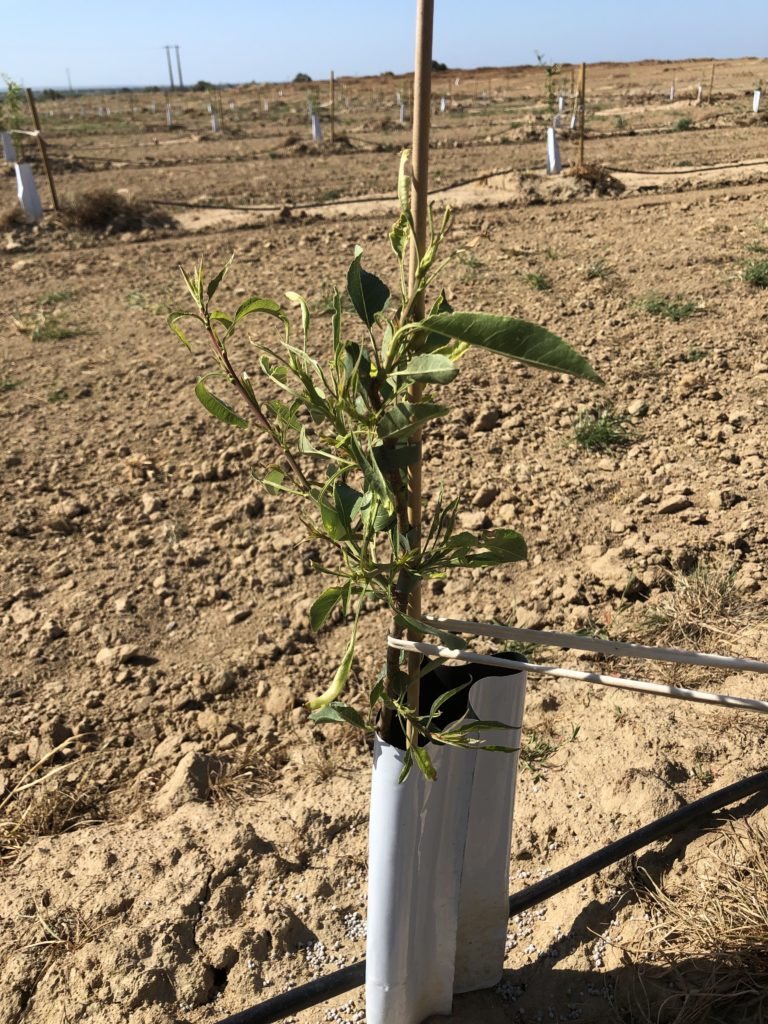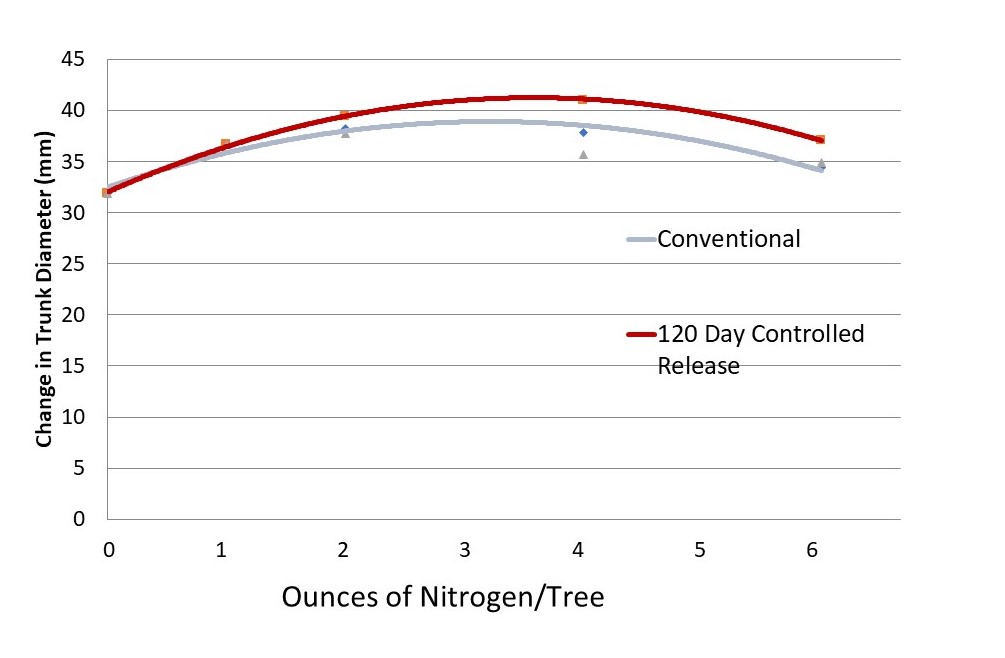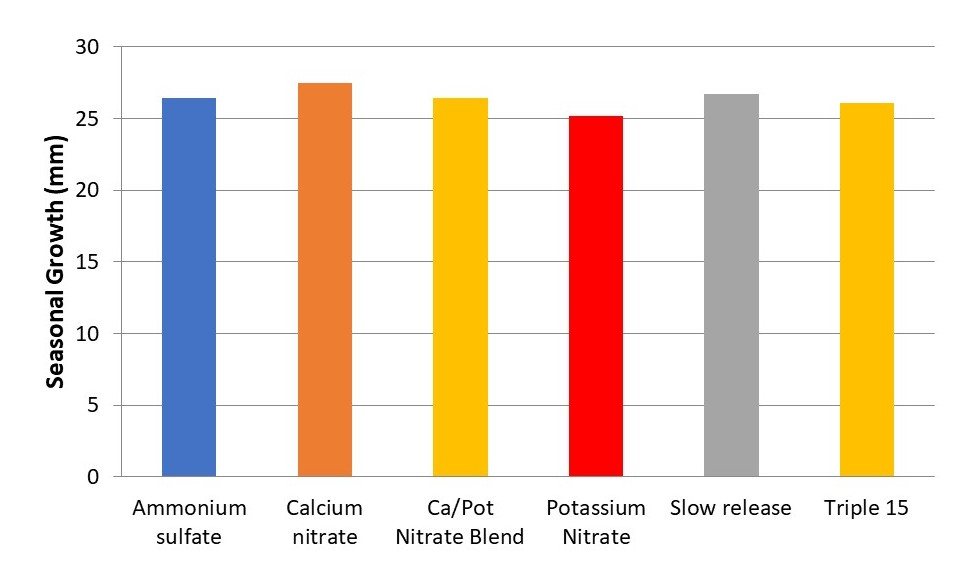Determining fertilizer needs for newly planted orchards is challenging. This is due to the desire to grow the trees as rapid as possible while considering the risk of uptake burn and irrigation system inefficiencies. To determine the optimal fertilizer plan, the amount and type of nitrogen and other nutrients need to be considered.

Nitrogen: Rate studies conducted in California have found that tree growth seems to peak with 3-4 ounces of nitrogen application per tree. This is based on three different studies – one located near Arbuckle, CA and the other two in Merced County. Within the most recent studies in Merced County, applications were made every three weeks from April through July for a total of six applications. A total of 0, 1, 2, 4, and 6 ounces of actual nitrogen was applied during this period to replicated plots using a NPK blended fertilizer.
The source of nitrogen did not create a difference in trunk caliper in the multiple studies within Merced County. Very simply stated, “nitrogen is nitrogen.” There are benefits, however, to the various nutrients that are within fertilizers. If soil levels of phosphorous or potassium are low, utilizing an NPK blend would provide an addition of these major nutrients. The same could be said about calcium-containing fertilizers. If these nutrients are at sufficient levels for plant growth, however, there is minimal benefit from adding additional amounts.

Potassium and Phosphorous: Within California conditions, phosphorous (P) and potassium (K) do not appear to be the limiting factor with most soils. The two trial locations within Merced County were located on sandy soil and found no increase in growth from the inclusion of P and K within the fertilizer programs. This does not mean that these major nutrients are not important, rather that many soils contain adequate levels of P and K to support first year growth.
Many soils world-wide are deficient in these major nutrients. Due to these variations, pre-plant soil tests should be conducted to determine the amount of P and K needed. Amending the soil pre-plant provides an opportunity to apply lower cost fertilizers at higher rates without impacting the plant. If soil sufficiency levels are variable or unclear, adding additional P and K within the fertilizer program does not appear to negatively impact tree growth and, depending on soil type, may build a reserve for future year’s use.

Application method: This study did not account for the inefficiencies of fertilizing through the water. In these situations, water containing fertilizer may be applied outside of the rootzone of the tree. In these situations, it may be needed to increase the amount of nitrogen applied to make sure that the proper rate is being applied to the root zone. In any single application, however, the rate of nitrogen should not exceed 1 ounce of actual nitrogen for the first year of growth. Applying less nitrogen more frequently will reduce the risk of uptake toxicity.
Use of granular fertilizers will require water to move the nitrogen into the rootzone. This can be accomplished using micro-sprinkler irrigation or rain. Use of granular fertilizers with drip systems can create complications in moving the material into the rootzone. If drip is being used within the orchard, and there are no other options for fertilizing, apply the material within the wetting pattern of the irrigation system.
Controlled release fertilizer was also utilized in the Merced study. It found that a large, single application providing the entire season’s fertilizer needs can be made. This single application provided the same growth response as multiple applications of the conventional blended fertilizer. Application costs, however, were reduced significantly, offsetting the increased cost of the fertilizer. This may provide a reduced labor alternative for growers who wish to apply fertilizer by hand.
Fertilizer rate. First year fertilizer needs are described as rate per tree. This will allow the site-specific amount to be determined as higher densities will require more nitrogen to develop the orchard. For example, at one ounce of nitrogen per tree, this would equal 8 and 10 pounds of nitrogen per acre for a 128 and 160 tree/acre planting, respectively. Inefficiencies of nitrogen and the application method need to be added to this amount to reach the application total.
Application timing. The first application of nitrogen to young trees should occur when there is 8-12 inches of growth. Fertilizing too soon may lead to tree damage by uptake and increased salt concentrations in the rootzone. Fertilizing too late may lead to lost growth for the season. Once the first application has been properly timed, application can continue on an every three-to-four-week basis, with the last application being applied in late summer. Multiple, small applications will have a greater efficiency than fewer, larger applications.

